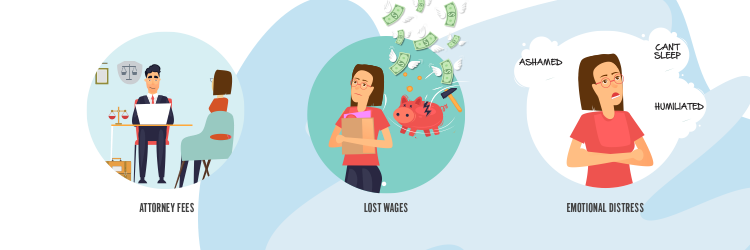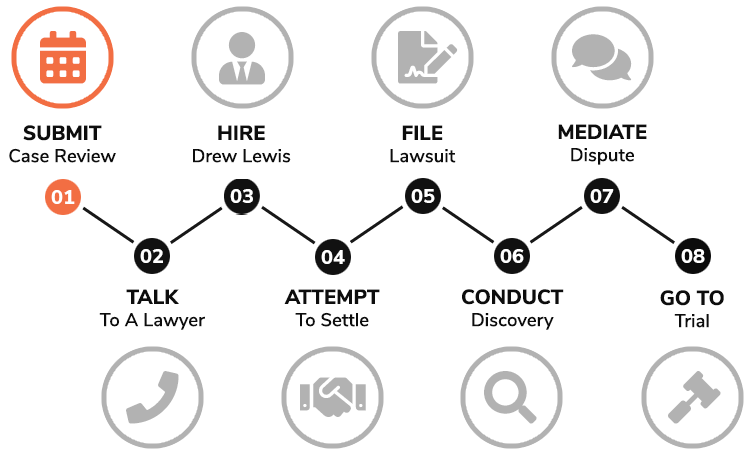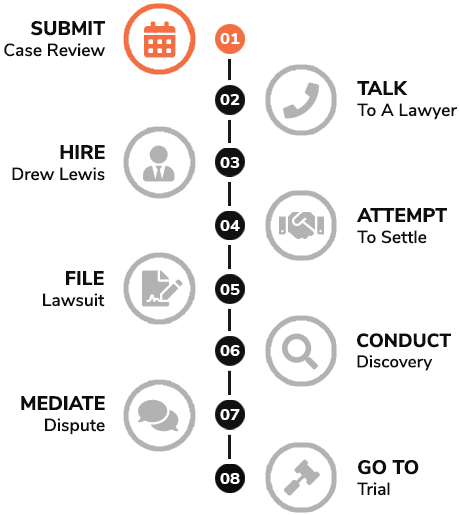


Drew Lewis
Last Updated:
- January 12, 2025
- What is the definition of workplace sexual harassment?
- How can you stop sexual harassment at work?
- Are you protected when you report sexual harassment?
Article Contents:
Section #1: What is sexual harassment?
Section #1
What is sexual harassment?

- “Quid pro Quo” harassment, and
- “Hostile work environment” harassment.
I'm Ready
[ return to top ]
Section #2: Hostile Work Environment Sexual Harassment
Section #2
Hostile Work Environment Sexual Harassment

1) The behavior must be unwelcome
Example:
2) The behavior must be based on your sex/gender
3) The harassment must be severe or pervasive
- Sporadic,
- Occasional,
- Isolated,
- Trivial
Example:
I'm Ready
[ return to top ]
Section #3: Quid Pro Quo Sexual Harassment
Section #3
Quid Pro Quo Sexual Harassment

- A promotion
- Better work schedule
- Title/position
- Compensation
- Not firing you
Example:
I'm Ready
[ return to top ]
Section #4: Who is protected from workplace sexual harassment?
Section #4
Who is protected from workplace sexual harassment?

- Employees
- Independent Contractors
- Interns (paid or unpaid)
- Volunteers
Employers have an obligation to prevent workplace sexual harassment
California employers are not just responsible for responding appropriately to complaints of sexual harassment, they have an obligation to actively prevent it. They must prevent workplace sexual harassment, protect employees who report it, and ensure that victims and those who report harassment do not face adverse employment actions such as demotion, harassment, suspension or even termination.
- Providing mandatory sexual harassment training
- Timely and thoroughly investigating reports of sexual harassment
- Reassigning or disciplining, including firing, harassers
- Maintaining a work environment where victims and reporters are not retaliated against
I'm Ready
[ return to top ]
Section #5: Who can commit sexual harassment?
Section #5
Who can commit sexual harassment?

One misconception about California workplace sexual harassment is that only supervisors and bosses can commit it. In reality, your employer has an obligation to protect you from sexual harassment form most people you might come into contact with in the workplace. This includes:
- Owner, supervisor or boss. When a supervisor or boss harasses you, the law considers the harassment as an act of the company itself. Additionally, the harassment of a co-worker can be attributed to the company if your supervisor or boss fails to fix the situation, for example, by firing or reassigning the harasser.
- Non supervisor coworkers. Coworkers can sexually harass others who are on equal levels, but they can also harass up or down the organizational chart. When you are harassed by a co-worker who is not a supervisor, in order for the company to be liable for the co-worker’s sexual harassment, you must first notify the company. If the company fails to act, then it could be responsible to you for damages.
- Third parties (vendors, consultants, clients, customers, etc.). Third parties who are not employees of the company can commit sexual harassment against you or other employees. An example could be a vendor offering to sign a contract with you in exchange for sexual favors. Another example is a third-party business consultant engaging in ribald and sexual humor even after you explain you’re not comfortable with it and ask them to stop..
I'm Ready
[ return to top ]
Section #6: Examples of Sexual Harassment
Section #6
Examples of Sexual Harassment

Common examples of verbal sexual harassment
- Cat calls or wolf whistles
- Unwanted sexual jokes or teasing
- Unwanted and inappropriate comments about your gender or things related to your gender, including talking about parts of your body or your appearance
- Unwanted questions about your sexual orientation, sexual experience or sexual desires
- Referring to you or someone of your gender in potentially derogatory phrases
- Turning discussions at work to sexual topics
- Telling sexual stories or making innuendos
- Comments about your clothing or anatomy that are of a sexual nature
- Making sounds that imitate sexual actions, including kissing sounds or sounds typically associated with the act of intercourse or orgasm
- Spreading rumors about someone’s sex life
Common examples of physical sexual harassment
- Someone touching you in an unwelcome manner, including stroking your hair, holding a hand on your back or even brushing up against you repeatedly — especially when there is no physical or special need to do so
- Someone giving you an unwanted neck or shoulder massage, especially without asking or if you have stated that you don’t want to be touched
- Unwanted hugging, stroking or any other physical contact
- Standing very close to you or cornering you against a wall or other obstruction
Common examples of nonverbal sexual harassment
- Looking you up and down in a suggestive manner or staring pointedly at certain areas of your body
- Giving you unwanted or inappropriate gifts
- Displaying vulgar symbols or gestures to you, about you or around you
- Imitating sexual activity with their body or hands
I'm Ready
[ return to top ]
Section #7: Male Sexual Harassment in the Workplace
Section #7
Male Sexual Harassment in the Workplace

Examples of Male Sexual Harassment in the California Workplace
- Referring to you by female pronouns
- Sexual taunting
- Simulate sex acts
Jobs where Male Sexual Harassment Commonly Occurs
- Hotel and restaurant jobs
- Construction jobs
- Manufacturing jobs
- Waste management jobs
- Sales jobs
I'm Ready
[ return to top ]
Section #8: How to stop workplace sexual harassment
Section #8
How to stop workplace sexual harassment

In many cases, the California company needs to be provided the opportunity to fix the situation. And without the opportunity, you might not be able to pursue a harassment claim.
1) Confront the Harasser
Caution:
2) Report the conduct
After confronting their harasser, some California workers are content that the issue has been resolved. If you are concerned that it will continue, you should also report the behavior to the company. Some companies have their own internal complaint-making process. This can be found in the company handbook. If your company does have a defined process, then you should follow that process.
3) Document the harassment and your reports to the company
- What was said or done
- The date and time it occurred
- How you responded
- Who was involved
- Who witnessed the incident(s)
- Keeping a journal of your experience
- Sending emails to yourself (using your personal email address) of the harassment immediately after it happens
- Filing a report with your employer when experiencing harassment
- Contemporaneously made (made at the time or shortly after the incident or report), and
- Detailed and Specific (describes who, what, where, when, why)
Not Great | Joe sexually harassed me on June 3. |
Better | Joe touched me at work on June 3 in a way that I felt uncomfortable with. He started rubbing my shoulders and I told him that he did not need to do that. |
Best | On June 3, I was working at my desk. It was around 8:15am when Joe came up behind me. He put his hands on my shoulders and started to rub them. He told me "you looked stressed." I responded that "I am ok" and tried to move away. He said "let me help you out." I told him that "you don't need to. It is ok. I am fine." |
I'm Ready
[ return to top ]
Section #9: How to recognize and prevent retaliation for reporting sexual harassment
Section #9
How to recognize and prevent retaliation for reporting sexual harassment

It is illegal to discriminate, retaliate or terminate an employee for reporting workplace sexual harassment in California, even if the behavior turns out not to be sexual harassment. Sometimes someone other than the victim reports the harassment and experiences retaliation. Whether you are the victim or the reporter, you have the right not to be protected from retaliation.
- Try to escape sexual harassment
- Decline a boss or supervisor’s unwelcome sexual invitations
- Tell the harasser to stop
- Report sexual harassment to supervisors or superiors
Common forms of Retaliation
- Firing
- Failing to promote
- Demotion
- Reassignment with significantly different responsibilities
- Reduction in compensation
- Loss of benefits
- Suspensions
- Lateral transfers
- Denial of flex time
- Negative job references and evaluations
- Firing
- Failing to promote
- Demotion
- Reassignment with significantly different responsibilities
- Reduction in compensation
- Loss of benefits
- Suspensions
- Lateral transfers
- Denial of flex time
- Negative job references and evaluations
How to prove retaliation
I'm Ready
[ return to top ]
Section #10: Should you quit if you’re experiencing sexual harassment?
Section #10
Should you quit if you’re experiencing sexual harassment?

What is a constructive discharge?
- The workplace was so hostile that a reasonable person would feel compelled to quit under the same circumstances, and
- The employer knew or should have known of the hostile conditions or that the employer demonstrated an intent to force you to resign
Tip:
I'm Ready
[ return to top ]
Section #11: What types of damages can be recovered in sexual harassment cases?
Section #11
What types of damages can be recovered in sexual harassment cases?

Attorney’s Fees and Costs
Lost Wages
- Backpay - is the amount of wages you lost from the time that you were terminated or quit up to the time you found a new job. If you currently find yourself in this position, you should know that you have an obligation to “mitigate your damages” which is a legalese way of saying you have to go and look for a job—you can’t just sit at home while you accrue backpay damages in hopes of a big payout in a lawsuit.
- Front pay - is the difference in pay between the job you were terminated from or quit and the job you found immediately after leaving the company where you experienced the sexual harassment.
Emotional distress
- Insomnia
- Embarrassment
- Shame
- Loss of appetite
- Humiliation
- Marital issues
- Loss of desire of sex
- Reputation loss
- Unable to pay rent
- Loss of healthcare
- Unable to seek medical treatment
Example:
Punitive damages
Reinstatement
Change in policies and practices
I'm Ready
[ return to top ]
Section #12: How long do you have to file a sexual harassment lawsuit?
Section #12
How long do you have to file a sexual harassment lawsuit?

When does clock start running to file a lawsuit?
- The conduct ends or is brought to an end, or
- You realize that further effort on your part to end the conduct would be futile
When has the sexual harassment ended?
Example:
When would further efforts to stop the harassment be futile?
Example:
I'm Ready
[ return to top ]
Section #13: How do you file a sexual harassment lawsuit?
Section #13
How do you file a sexual harassment lawsuit?

Tip:
Filing a Complaint with the Department of Fair Employment and Housing (DFEH)
Tip:
Investigating the Claim
- Dates
- Times
- Locations
- Witnesses
Tip:
Obtaining a Right to Sue Letter
Filing a Charge with the Equal Employment Opportunity Commission (EEOC)
Limit on Emotional Distress & Punitive Damages:
| Employer Size: | Limit: |
|---|---|
| 1-14 employees | Federal law doesn't cover |
| 15-100 employees | $50,000 |
| 101-200 employees | $100,000 |
| 201-500 employees | $200,000 |
| 500+ employees | $300,000 |
Filing a Lawsuit in Court
Before you can file a sexual harassment lawsuit in California, you are first required to file a claim with the Department of Fair Employment and Housing in order to obtain what a “right to sue” letter. Obtaining the letter is a formality and just signifies that you have satisfied one of the requirements necessary to file a workplace harassment lawsuit. If you fail to obtain a right to sue before filing your lawsuit, your lawsuit and legal claims could be barred completely.


Tip:
I'm Ready
[ return to top ]
Section #14: Do I have a case?
Section #14

